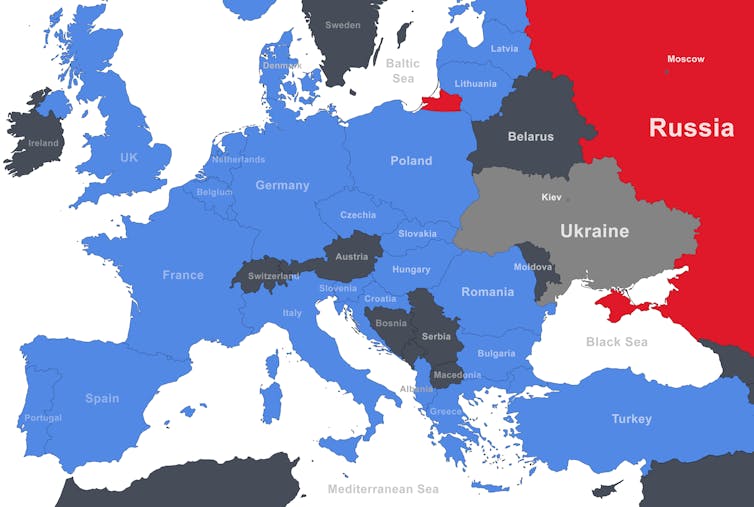One year of war and Russia is still mired in its second invasion of its neighbour’s internationally recognised territory – which turned out to be much bloodier and more devastating than the first due to Ukraine’s incomparably stronger resistance.
The war’s international dimension has been dramatically emphasised by the recent visit by US president Joe Biden to a country where there is no concentration of US troops. Nato countries are increasing their support to Ukraine despite all speculation about fatigue settling in among them.
And Beijing is about to submit a peace plan, duly consulting Moscow beforehand – since they are supposedly bound by “limitless friendship”.
Since Vladimir Putin sent his war machine into Ukraine on February 24 2022, The Conversation has called upon some of the leading experts in international security, geopolitics and military tactics to help our readers understand the big issues. You can also subscribe to our weekly recap of expert analysis of the conflict in Ukraine.
Vladimir Putin’s recent speech offered no perspective of peace, instead blaming the west for the conflict: “They [the west] started the war. And we used force and are using force to stop it.”
To help understand how the world reached this dangerous juncture – and to reach as fair as possible a judgment about it – we need to first consider the historical perspective. There are basically two conflicting descriptions of the chain of events leading to the Russian invasion of Ukraine on February 24 2022.
View from the Kremlin
One description – we shall call it the pro-Russian version – presents that invasion as Moscow’s reaction to three decades of US-led western encroachment into its former sphere of domination, as part of a US drive to global hegemony.
The two major rounds of Nato’s eastward enlargement were perceived by Russia as hostile and provocative gestures. All the more so since Russia itself was never invited to join the alliance whose raison d’être has precisely been to counter it after the second world war. Poland, Hungary and the Czech Republic were admitted as Nato member states in 1999 against the backdrop of the first US-led war since the end of the cold war that circumvented the UN security council, thus violating international law: the war in Kosovo.
Six more states formerly dominated by Russia were integrated into Nato in 2004 (along with a seventh that belonged to former Yugoslavia). They included three former Soviet republics – the three Baltic states: Latvia, Lithuania and Estonia. The backdrop this time was the US-led invasion of Iraq that had started the year before, circumventing the UN security council one more time and constituting yet another Washington-led violation of international law.

Viacheslav Lopatin via Shutterstock
The previous year, George W. Bush unilaterally scrapped the anti-ballistic missile treaty to Moscow’s great discontent. So, when he insisted at Nato’s Bucharest summit in 2008 on promising membership to Georgia and Ukraine, Vladimir Putin felt prompted to act before Russia found itself sharing a long border with a hostile North Atlantic alliance.
Events in Georgia in 2008 and Ukraine in 2014 were the consequence of this. Putin eventually ordered the invasion of Ukraine in a (failed) attempt to achieve “regime change” in that country like the US had tried and botched in Iraq.
Nato’s version
The opposite description – we shall call it Nato’s version – portrays Russia’s invasion of Ukraine as the child of Putin’s delusions of grandeur and his ambition to reconstitute the imperial domain of tsarist Russia and the Soviet Union.
Since becoming Russia’s president at the turn of the century, Putin has gradually increased the concentration of power into his hands and become more and more authoritarian. This process accelerated after his comeback to the presidency in 2012, after the interim period during which he was formally replaced in that role by his stand-in Dmitry Medvedev, while continuing to pull the strings from the prime minister’s seat.
Confronted with massive opposition to his return, Putin felt threatened by the prospect of a western-sponsored “colour revolution” against his rule. He invaded and annexed Crimea in order to boost his legitimacy, knowing how popular that annexation would be in Russia.
His success in this endeavour and the relative moderation of western reaction – along with the effect of his protracted self-isolation for fear of catching COVID – led him to envisage a further step in pandering to Russian nationalism by subduing Ukraine. He tried to achieve this by invading it and has so far failed miserably due to the country’s resistance exceeding all expectations.
Cool heads must prevail … or else
Which of these two narratives is right? The objective answer to this question is: both. They are both true and there is no contradiction between them – in fact, they fully complement each other. That is because Washington’s post-cold war behaviour provided the perfect conditions for the growth of Russian revanchism that Vladimir Putin came to embody.
Where does the recognition of the above two sets of facts leave us regarding the continuing war? There is no doubt that the main responsibility in the present tragedy falls on Russia. Its invasion of Ukraine was unprovoked and openly premeditated.
Presuming that Putin had believed that most Ukrainians would welcome his “special operation”, he should have cancelled it and withdrawn his troops as soon as it became clear that he was mistaken. Instead, he got his country’s military bogged down in a long murderous and destructive war in eastern Ukraine.
Russia must withdraw its troops to where they stood before February 24 2022. As for Crimea and those parts of Donbas that were controlled by Russian-backed anti-Kyiv forces since 2014, their status should be settled by peaceful and democratic means compatible with the UN Charter, along with the deployment of UN troops in the disputed territories.
The world cannot afford a new world war in order to reinstate these rules. The new cold war, launched by Washington less than a decade after the end of the first one and now embodied by Russia’s murderous invasion of Ukraine and by perilous sabre rattling around Taiwan, must end before it leads to Armageddon.
![]()
Gilbert Achcar's latest book: The New Cold War: The US, Russia and China from Kosovo to Ukraine is published by The Westbourne Press.











